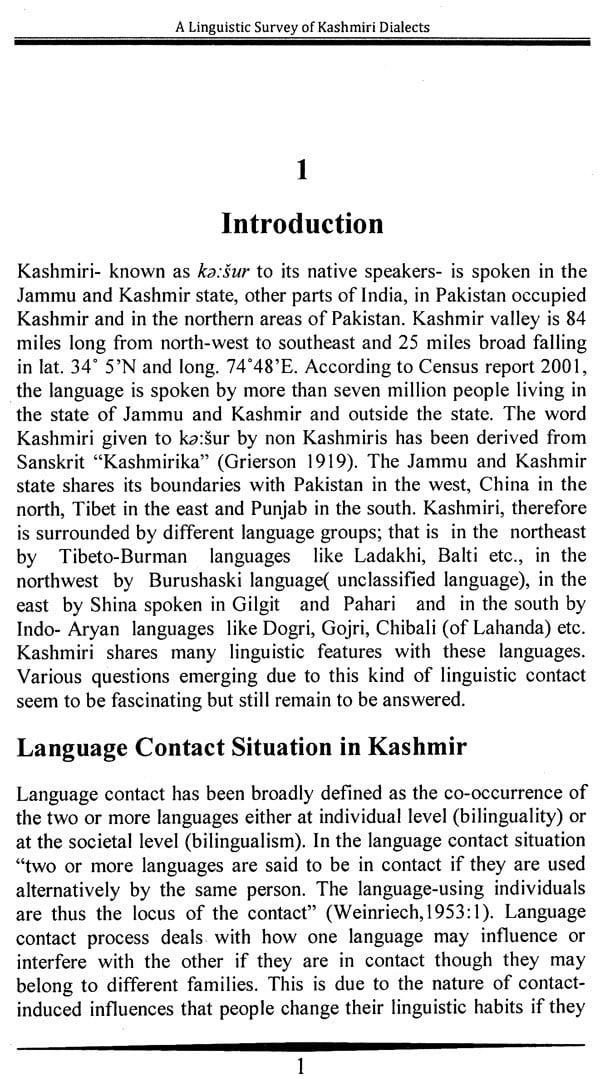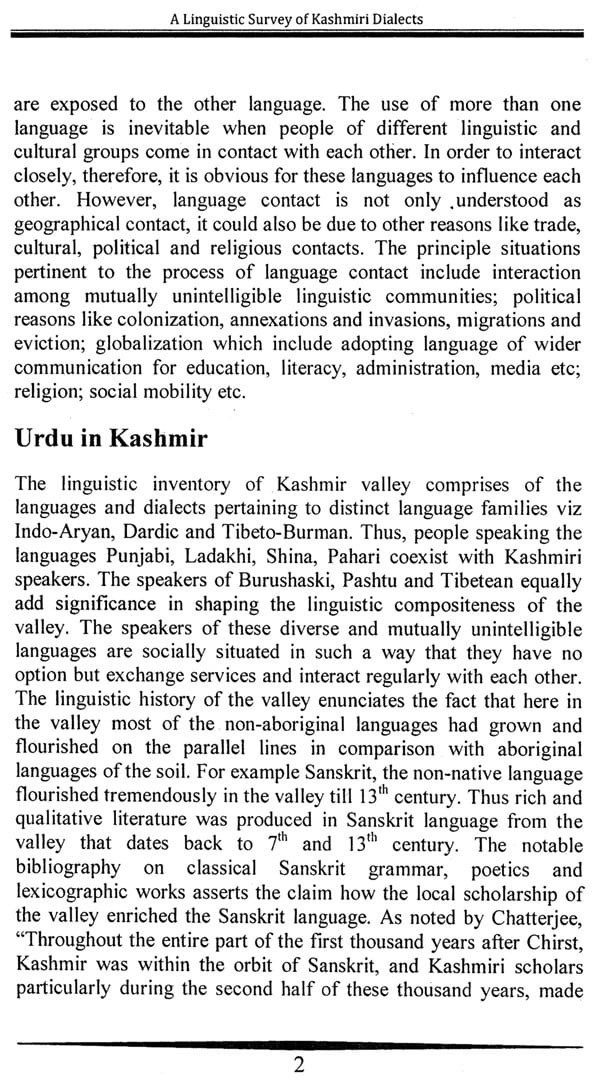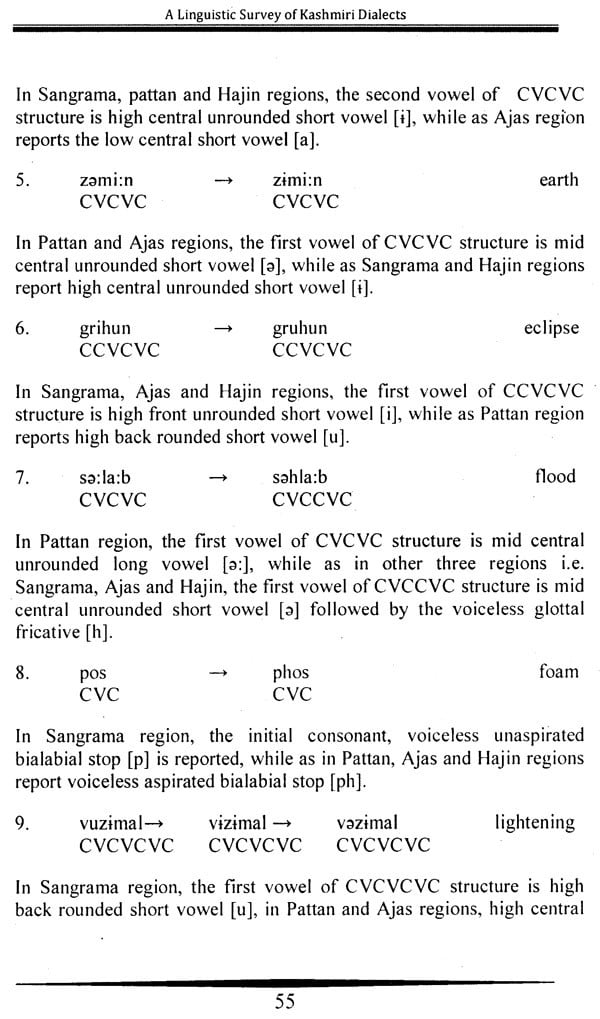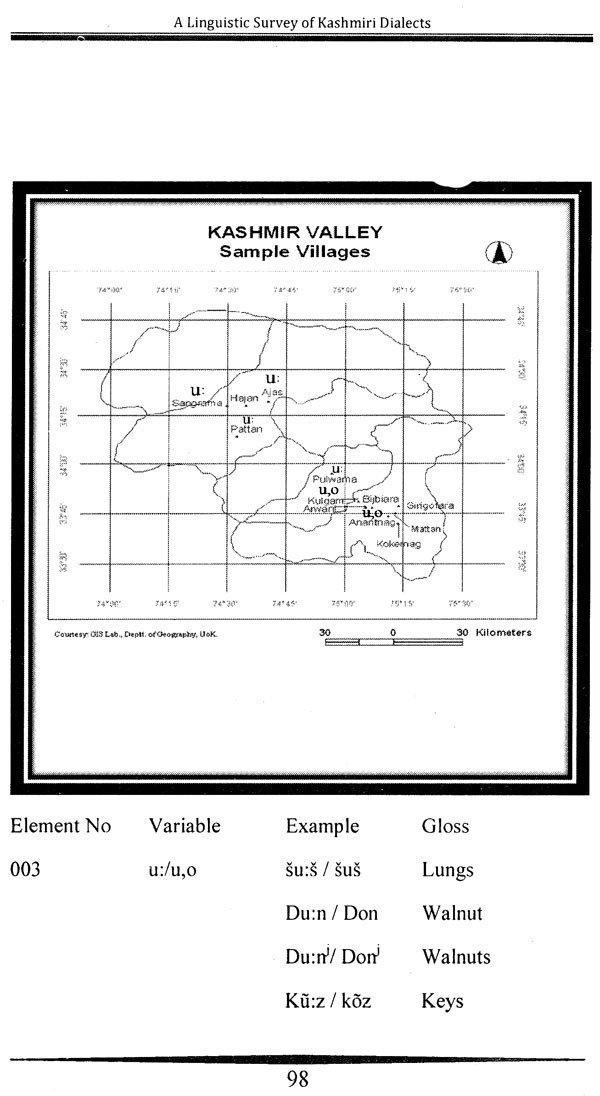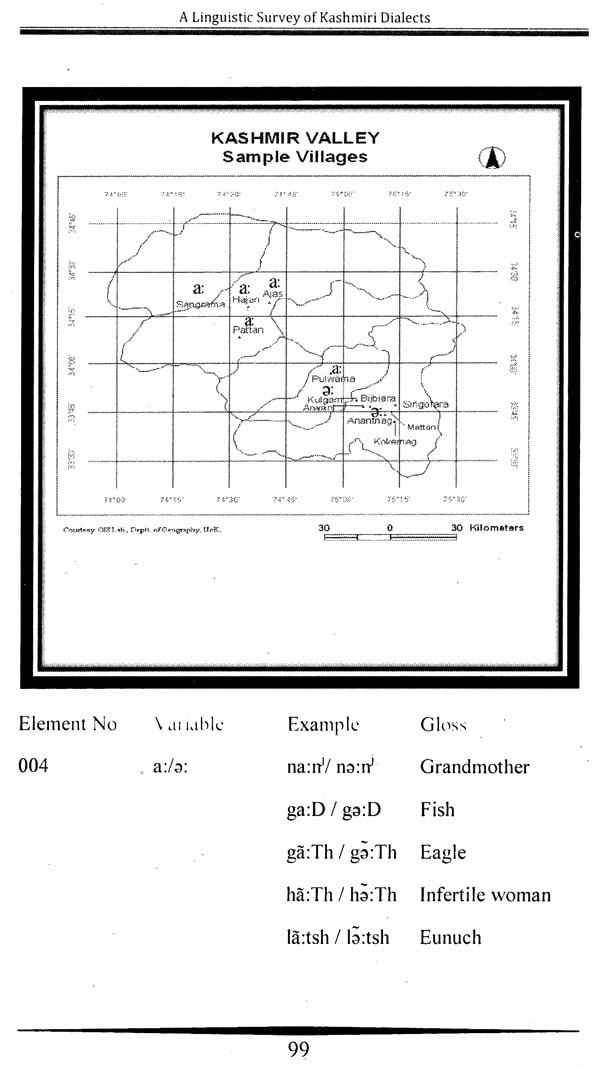
A Linguistic Survey of Kshmiri Dialects
Book Specification
| Item Code: | NBZ471 |
| Author: | Rajesh Sachdeva, Nazir Ahmad Dhar and Maharaj Krishen Koul |
| Publisher: | Central Institute Of Indian Languages, Mysore |
| Language: | English |
| Edition: | 2010 |
| ISBN: | 9788173420962 |
| Pages: | 134 (Throughout B/W Illustrations) |
| Cover: | HARDCOVER |
| Other Details | 9.00 X 6.00 inch |
| Weight | 280 gm |
Book Description
Dialectological research is concerned with understanding the nature of linguistic variation, mechanism(s) of linguistic change; and developing comprehensive theories of language. George Wenker, the noted German dialectologist conceived the idea of dialect studies and developed the Linguistic Atlas of German Language in 19th century. Realizing the relevance as well as the need and importance of dialect studies, detailed Dialect/ Linguistic Atlases have appeared on various languages spoken in the European Peninsula which include English, Swedish, Danish, Scottish, and French etc. The material collected with respect to these languages in the perspective of dialect studies was found relevant in the field of applied linguistics particularly in the areas like Lexicography, Language Teaching and Language Pedagogy. In the backdrop of this significance of dialect surveys, the languages spoken in America and Canada have been explored with highly developed techniques of dialectological principles.
The Linguistic Atlas of America and Canada is the best suited example of this endeavor. Many of the languages spoken across the country have been explored in the framework of dialectology. H. S. Gill (1977) has developed the Linguistic Atlas of Punjabi which has anthropological linguistic orientation. A. M. Ghatage (1969) worked and brought out "A Survey of Marathi Dialects". Unlike other languages spoken in the Indian subcontinent, Kashmiri language, although showing good potential of dialect variations, has not been studied rigorously so far on the basis of modern techniques and methods. Grierson (1919) had given a brief outline of dialect of Kashmiri language spoken outside Pir Panchal range. Over five decades back, in 1966, Abdul Khaliq Tak Zainagiree, a Patwari by profession, prepared a monumental sketch of lexical variation of Kashmiri language in various geographical regions under the title of "ka:siri zaba:n manz ala:kiwa:d phe:r". Kachru (1967) and Koul (1988) made a brief mention of social dialects of Kashmiri language on the basis of religion and have drawn linguistic variation with the terminologies.
like Hindu-Kashmiri (with profound Sanskrit influence on Kashmiri vocabulary) and Muslim-Kashmiri (with profound influence of Persian on Kashmiri vocabulary). In the light of the social change of the modern world in the form of globalization and information technology, the dialect study has become an indispensable need of the hour. The old methods have been revisited and new methods have been framed. Central Institute of Indian Languages, Mysore-the premier institute for facilitating linguistic research in Indian languages, both major and minor, was established at Mysore in the year 1969. It was charged with the responsibility of conducting research in the areas of language analysis, language pedagogy, language technology and dialectology.
In an advisory capacity the Government of India entrusted it with the responsibility of advising many countries to frame their language policies. As a nodal agency for the documentation, description and development of all Indian languages, it has collaborated with many state and central agencies. The present project 'Survey of Kashmiri Dialects' was undertaken by CIIL, in the year 2008 in collaboration with the Department of Linguistics, University of Kashmir, Srinagar.
This project will be done phase-wise; in phase-I the target was to carry out the dialect survey in the valley of Kashmir. The fieldwork pertaining to the project has been carried out by trained field workers, covering areas like Srigufwara, Mattan, Anantnag, Kokernag, Doru, Pahalgam, Bijbehara, Kulgam, Shopian, Pulwama, Srinagar, Baramulla, Pattan, Ajas, Bandipora, Hajin, Sopore and Kupwara etc. The data collected from the field has been processed, analyzed, generalized and compared across different regions of the valley. The linguistic variations identified have been specified on maps to evolve the notion of dialect Atlas of Kashmiri Language spoken in Kashmir valley. In view of the social relevance, the findings of the project are being brought out in the present book to make the study socially useful and to invite timely feedback as was suggested by the review committee. The review committee meetings were held in the Department of Linguistics, University of Kashmir, Srinagar and Urdu Teaching and Research Centre, Lucknow. The speakers of Kashmiri language are the real owners of the book.
The language consultants engaged during the fieldwork have generously cooperated with the field workers. We whole heartedly record with thanks the cooperation and patience shown by them during the challenging fieldwork. Prof Peri Bhaskararao an internationally renowned phonetician attended a meeting as an expert and vetted the first volume and offered valuable suggestions. We acknowledge with thanks the suggestions given by him. Omar N. Koul- a well known scholar in the field of Linguistics in general and Kashmiri linguistics in particular - spent enough time with his wisdom and sincerity to shape the book in the present form at Urdu Teaching and Research Centre, Lucknow. We are deeply indebted to him and acknowledge his efforts with thanks. Last but not the least; we are thankful to the press that has accepted the task and brought out the publication in record time.
Leonard Bloomfield in his book Language (1 933) had postulated the hypothesis that less the frequency of interaction between people more is the linguistic diversity between their speeches. The linguistic diversity on the basis of interaction factor becomes so deep that a sharp cleavage can be drawn among the people speaking the same language but inhabiting different geographical spaces. This ultimately becomes the natural basis for dialect variation. The modern science of dialectology has cautioned that diverse forces are constantly at work to diversify a language into various dialects, which if accompanied by identity movements may even set them apart as separate languages unless people retune their subjective world to transcend the objective difference and accept them as natural and alternate realizations of the same language. Apart from geographical segregation of population which undoubtedly packs up language into geographical or regional dialects, other social factors like caste, ethnicity, socio-economic class or gender may also become socially significant causes for variations.
The branch of language studies which correlates speech variations with social structure of the society has been conceived into a special discipline popularly known as social dialectology. Both the studies, i.e. geographical dialectology or regional dialectology and social dialectology have occupied centrality in linguistics concerned with variation studies. The history of the people and their language, the social structure and social organization of the society, the phenomena of external language contact are some of the issues that have figured often in dialect studies. Therefore, viewing linguistics in the framework of social sciences, these issues aim to address how the people and the language(s) they Speak in a given speech community are organized in relation to one another and how social contexts intervene to frame variation. Dialectology has thus become the concern of inquiry for those engaged in unraveling the forms of language and pursuing the coming into being the diversity of languages. However, Kashmiri language has not had the benefit of this new paradigm of research.
While taking note of all earlier studies the present attempt is to systematically document and describe the nature of variation. We hope each variety will also be seen as complete and unique with its own rich resource base and the study of linguistic diversity will enrich their study of language as a whole. The other issues like linguistic classification of Kashmiri language, the linguistic contact that Kashmiri language has undergone through ages, the history and migrations of the people will also emerge as embodied in language forms to further that understanding of unity in diversity. In view of its academic sensitivity and importance, Central Institute of Indian Languages, Mysore, has initiated the work on Survey of Kashmiri dialects in collaboration with the Department of Linguistics, University of Kashmir, Srinagar.
It commenced with a five day workshop at the Department of Linguistics, University of Kashmir, Srinagar in the month of June, 2008. Its prime objective was to develop the • vision document of the dialect survey project and to specify the methods and approach as well as the resources. Senior faculty members of various language departments and some social science departments of the University of Kashmir were involved in the workshop. As a result of the fruitful discussion it was felt that the survey should be done in different phases:
a) Phase - I (Within the valley)
b) Phase-II (Outside the valley)
c) Phase - III ( Other Kashmiri speaking regions)
The work for phase-I started in the month of September, 2008, which has been completed. It gives me immense pleasure that findings of Phase-I are now being published in the present book for public use. We hope it also paves the way for future researchers working in this area of study. I thank Nazir Ahmad Dhar and Maharaj Krishen Koul, who have been pursuing the work with sincere efforts. The budding linguists of Kashmiri Language involved in the capacity of Research Associates in the project namely Neelofar Hussain Wani, Irshad Ahmad Naikoo, Tanveer Ahmad and Parvaiz Ahmad Ganai deserve appreciation for they have taken to their work in all earnestness. I also record my best wishes and gratitude for the Kashmiri speaking community in general and language consultants in particular for providing the desired information to our fieldworkers as without their cooperation, the present form of work would have never surfaced. We hope this study will allow Kashmiri linguistics to take a leadership role in the study of South Asian Languages. My hope is the speakers of the language across the border will also come forward to add more materials and bridge our understanding in the growth and development of language.
**Content and Sample Pages**

